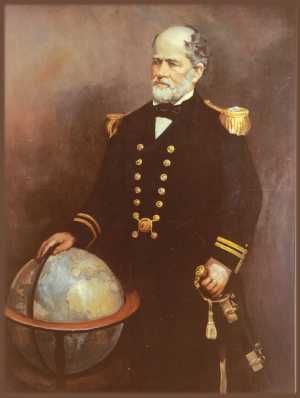 SKC Films Library SKC Films Library |
|
|
| SKC Films Library >> Geography >> Oceanography |
 Matthew Fontaine Maury Matthew Fontaine Mauryauthor of the first popular textbook on marine science Matthew Fontaine Maury was born in Spotsylvania County, Virginia, on January 14, 1806; his family moved to a farm near Franklin, Tennessee, when he was five. He graduated from Harpeth Academy in 1825, and then followed his older brother into the U.S. Navy. Maury entered the Navy with hopes of learning all there was to know about the sea, but the education-master aboard his first assignment lacked sufficient teaching materials and freedom to actually teach his charges anything. His second voyage proved equally disappointing, despite the fact that he had the distinction of sailing aboard the first U.S. sloop of war to circumnavigate the globe. During this voyage, however, Maury did take advantage of the ship's extensive library to educate himself in the fields of navigation. After passing his examinations before the Board of Naval Education he was assigned to a ship which subsequently sailed around Cape Horn to the west coast of South America. Finding information regarding winds and currents lacking, Maury began keeping his own meticulous records, which were subsequently published as "The Navigation of Cape Horn" in the American Journal of Sciences and Arts. Upon returning to the United States in 1834, Maury married Ann Herdon and settled in Fredericksburg, Virginia. While awaiting further orders he worked on the manuscript of A Treatise on Navigation, which was published in 1836. In 1839, a stagecoach accident left Maury lame and unfit for active duty. While convalescing he wrote a series of articles pressing for naval reform, especially regarding naval training and education. He also advocated the establishment of a naval academy which included instruction in chronometry, natural history, mathematics, and international and maritime law. These articles met with stiff opposition from the naval bureaucracy and made him more than a few enemies. Despite being disliked by the naval establishment, Maury's knowledge of the seas was still valuable, and in 1841 he was placed in charge of the U.S. Depot for Charts and Instruments. While serving in this capacity he developed the U.S. Naval Observatory's Hydrographic Office. In 1847 he began publishing his Wind and Current pilot charts of the North Atlantic, and after 1849 he had the use of two research vessels. In 1852-1853, he led a meeting of the world's ten major maritime powers in Brussels which resulted in all ten nations agreeing to the kinds of observations seamen should make and to how those observations were to be recorded and processed for the benefit of all mankind. In 1854 he published Bathymetrical Map of the North Atlantic Basin, which provided a profile of the Atlantic floor between Yucatan and Cape Verde that was subsequently used to help plan the laying of the TransAtlantic Cable. The result of all Maury's work to this point was Physical Geography of the Sea. Published in 1855, it became the first popular textbook on marine science. Maury's calls for naval reform eventually resulted in establishment of a special commission known as the Retiring Board. His enemies now had a way to get rid of Maury, for they used his lame leg to have him delcared "retired" from active duty; he was, however, allowed to continue his work at the Observatory. The value of Maury's work to seamen was hard to overcome, however, and a loud public outcry resulted in the order being revoked some three years after its issuance. In the years prior to the Civil War, Maury gave many lectures and wrote numerous articles urging reconciliation between North and South. But, after Virginia seceded from the Union in 1861, Maury reluctantly resigned his naval commission, gave up his Observatory, and offered his services to the Confederate Navy; he was quickly named head of the Confederacy's coast, harbour and river defenses. In 1861 he invented an electric torpedo, which became a very important part of the Conferate Navy's arsenal. In 1862 the Confederacy sent him to England, where he was charged with purchasing materials for his torpedoes. Maury's abilities proved so invaluable that the $3,000 price put on his head by the Union was second only to the price put on the head of Jefferson Davis, President of the Conferate States of America. And, in 1864, the National Academy of Sciences passed a resolution "that sailing directions, and wind and current charts, issued by Maury should no longer be used." The end of the Civil War temporarily left Maury without a country. The general amnesty offered to all Confederates specifically excluded anyone who had either acted as a Confederate diplomat or had resigned from a U.S. Military or Navy commission to join the South, and Maury was guilty of both. Unable to obtain a position of any kind within the United States, he attempted to form a colony of displaced Southerners in Mexico, where he was given the title "Imperial Commissioner of Immigration" by Emperor Maximilian and named Director of the Astronomical Observatory in Mexico. The colonization attempt ultimately failed, however, and the project was abandoned in 1866. Maury next took his family to England, where his immense popularity led to his being presented with a testimonial raised by public subscriptions. He was finally able to return to the United States after a more general amnesty was offered in 1868, and subsequently became Professor of Meteorology at the Virginia Military Institute. While serving in this capacity, he proposed establishment of a polytechnic college. That proposal resulted in the opening of the Virginia Polytechnic Institute in Blacksburg in 1872. Matthew Fontaine Maury became ill while on an extended lecture tour in late 1872. He died on February 1, 1873, and was buried in Lexington, Virginia; his body was later moved to Hollywood Cemetery in Richmond, Virginia, where it remains today. SEE ALSO |
| SKC Films Library >> Geography >> Oceanography This page was last updated on 05/04/2017. |